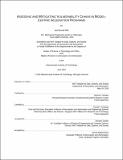| dc.contributor.advisor | Donna H. Rhodes and Daniel E. Hastings. | en_US |
| dc.contributor.author | Reid, Jack Burnett | en_US |
| dc.contributor.other | Technology and Policy Program. | en_US |
| dc.date.accessioned | 2018-09-17T14:49:42Z | |
| dc.date.available | 2018-09-17T14:49:42Z | |
| dc.date.copyright | 2018 | en_US |
| dc.date.issued | 2018 | en_US |
| dc.identifier.uri | http://hdl.handle.net/1721.1/117789 | |
| dc.description | Thesis: S.M., Massachusetts Institute of Technology, Department of Aeronautics and Astronautics, 2018. | en_US |
| dc.description | Thesis: S.M. in Technology and Policy, Massachusetts Institute of Technology, School of Engineering, Institute for Data, Systems, and Society, Technology and Policy Program, 2018. | en_US |
| dc.description | This electronic version was submitted by the student author. The certified thesis is available in the Institute Archives and Special Collections. | en_US |
| dc.description | Cataloged student-submitted from PDF version of thesis. | en_US |
| dc.description | Includes bibliographical references (pages 143-157). | en_US |
| dc.description.abstract | Acquisition programs increasingly use model-centric approaches, generating and using digital assets throughout the lifecycle. Model-centric practices have matured, yet in spite of sound practices there are uncertainties that may impact programs over time. The emergent uncertainties (policy change, budget cuts, disruptive technologies, threats, changing demographics, etc.) and related programmatic decisions (e.g., staff cuts, reduced training hours) may lead to cascading vulnerabilities within model-centric acquisition programs, potentially jeopardizing program success. Program managers are increasingly faced with novel vulnerabilities. They need to be equipped with the means to identify model-centric program vulnerabilities and determine where interventions can most effectively be taken. In this research, Cause-Effect Mapping (CEM), a vulnerability assessment technique, is employed to examine these vulnerabilities. Using a combination of literature investigation, expert interviews, and usability testing, a CEM is created to represent the novel vulnerabilities posed by model-centric practices in acquisition programs. Particular attention is paid to cybersecurity vulnerabilities, which pose a serious threat to the successful implementation of model-centric practices. From this CEM, key gaps in program manager knowledge and organizational policies are identified and potential responses proposed. | en_US |
| dc.description.sponsorship | Naval Postgraduate School Acquisition Research Programs Grant No. N00244-17-1-0011 | en_US |
| dc.description.statementofresponsibility | by Jack Burnett Reid. | en_US |
| dc.format.extent | 157 pages | en_US |
| dc.language.iso | eng | en_US |
| dc.publisher | Massachusetts Institute of Technology | en_US |
| dc.rights | MIT theses are protected by copyright. They may be viewed, downloaded, or printed from this source but further reproduction or distribution in any format is prohibited without written permission. | en_US |
| dc.rights.uri | http://dspace.mit.edu/handle/1721.1/7582 | en_US |
| dc.subject | Aeronautics and Astronautics. | en_US |
| dc.subject | Institute for Data, Systems, and Society. | en_US |
| dc.subject | Engineering Systems Division. | en_US |
| dc.subject | Technology and Policy Program. | en_US |
| dc.title | Assessing and mitigating vulnerability chains in model-centric acquisition programs | en_US |
| dc.type | Thesis | en_US |
| dc.description.degree | S.M. | en_US |
| dc.description.degree | S.M. in Technology and Policy | en_US |
| dc.contributor.department | Massachusetts Institute of Technology. Department of Aeronautics and Astronautics | |
| dc.contributor.department | Massachusetts Institute of Technology. Engineering Systems Division | |
| dc.contributor.department | Massachusetts Institute of Technology. Institute for Data, Systems, and Society | |
| dc.contributor.department | Technology and Policy Program | |
| dc.identifier.oclc | 1051211553 | en_US |
